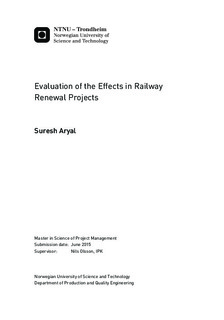Evaluation of the Effects in Railway Renewal Projects
Master thesis
Permanent lenke
http://hdl.handle.net/11250/2351180Utgivelsesdato
2015Metadata
Vis full innførselSamlinger
Sammendrag
The objective of this thesis is to evaluate the effect of the railway renewal project. The effects in the railway is generally evaluated after the completion and after the project is able to generate some data that can be expressed numerically to evaluate the proposed objectives as an ex-post evaluation of the project. It has been always interesting to measure the performances of railway system after executing changes, so the performances of the four renewed railway projects; Double track between Barkåker and Tønsberg, Gevinåsen tunnel between Hommelvik and Hell, Crossing tracks in Jensrud and Vålåsjø are evaluated. The defined parameters used to evaluate the performances of railway are line capacity, punctuality, travel time and standard deviations between the two stations nearby that includes the renewed railway infrastructure in between. It has been difficult to identify the exact tool out of number of tools that can evaluate the railway project more precisely.The thesis is mapped with the use of quantitative and qualitative approaches research techniques. The quantitative approach depending on the results derived from My train tool and Precision tool followed by statistical measurement, graphical representation and comparisons of the data set derived before and after the renewed railway projects were able to trace the quantitative change in the performance. In addition, the qualitative research technique followed by analytical comparisons between those two tools was able to predict the suitable tool for evaluation more precisely.Apart from the result, it has been experienced that there is a need for more evaluation parameters with sufficiently updated data to evaluate the railway project more precisely. Nevertheless, some of the solutions mentioned in the further research part of this thesis will aid in solving these problems.
Keywords: Railway, Punctuality, line capacity, travel time, deviation in travel time, evaluation tools
